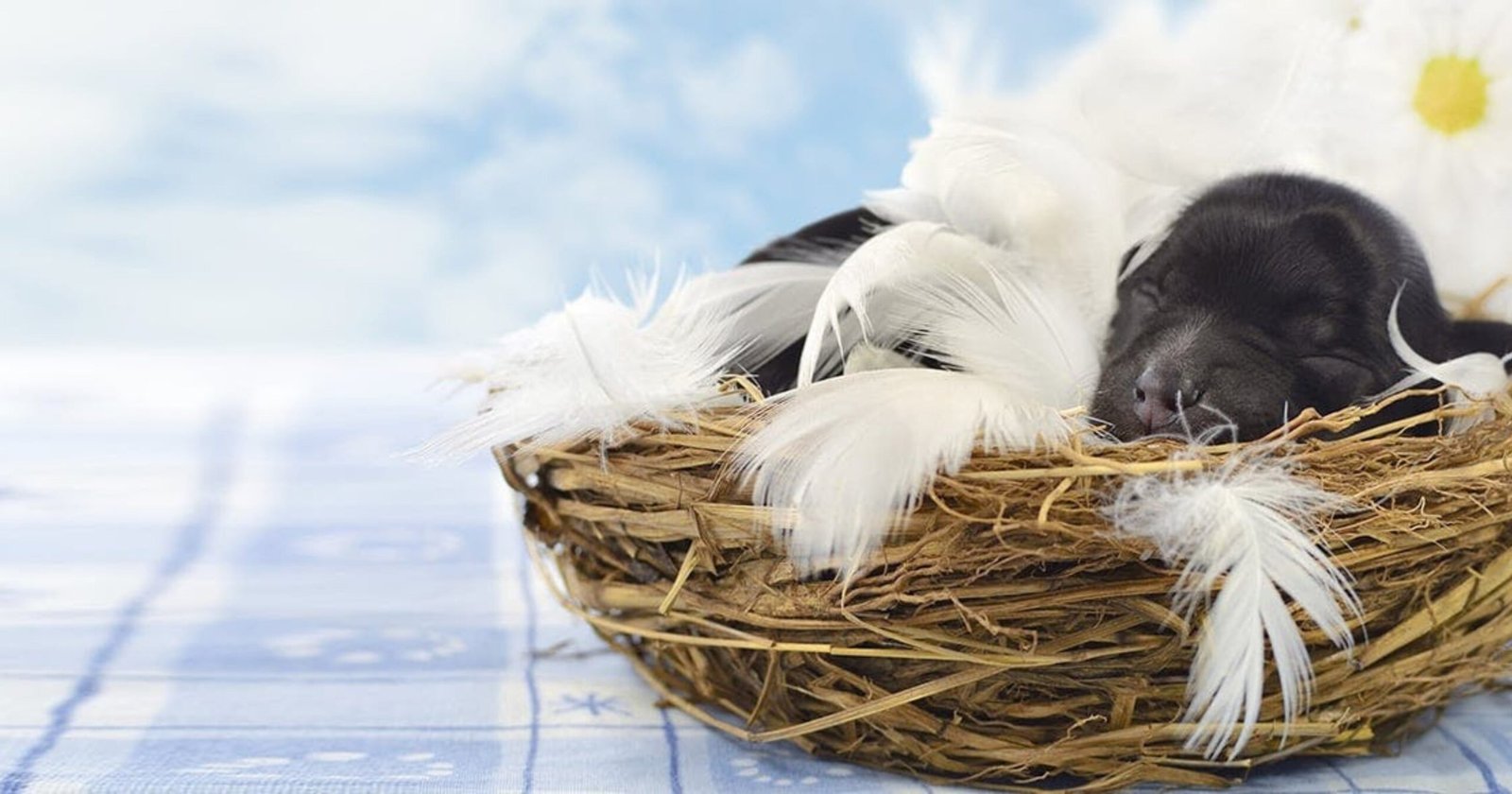Dogs, like us, have their unique ways of expressing comfort and security. One such behavior is nesting. Have you ever noticed your furry friend circling, scratching, and arranging their bed or a spot before lying down? This is their way of creating a cozy, safe space.
Nesting, or the nesting instinct, is commonly described as the maternal urge of a pregnant dog to create a secure and comfortable environment for giving birth to her puppies. This may involve activities such as relocating blankets, rearranging pillows, or stashing some laundry in the back of a closet for a cozy spot.
Read on for more information about what nesting behavior is for dogs and why they develop such strong attachments to certain places in their home! If you’re a dog owner, then you’ve noticed your pup’s nesting behavior at some point.
Reasons For Nesting Behavior In Dogs
Dogs are fascinating creatures, each carrying unique quirks and behaviors that make them distinct.
One such behavior is nesting, a habit that can intrigue dog owners and animal lovers alike.
Let’s dive into simple reasons behind “What Is Nesting Behavior In Dogs.”
1. Comfort and Warmth
First and foremost, dogs nest for the simple reason of being comfortable.
Just as humans fluff up their pillows or pull their blankets to get cozy, dogs, too, like to arrange their sleeping area to their liking.
Warmth is another significant factor.
Nesting behavior helps dogs trap body heat, especially on chilly nights, thereby providing them with a warm and snug sleeping environment.
2. Safety and Security
Safety and security are vital factors driving a dog’s nesting behavior.
In nature, dogs would circle and scratch a spot to chase away any bugs or snakes hiding in the grass, making the area safe for sleep.
This action has carried over into modern pet behavior.
Dogs also nest to create a safe, secure space in the house where they can retreat.
By providing a secure nesting spot, you are helping your dog feel more at ease and content in their environment.
Always respect this space and let them enjoy their nesting time in peace.
3. Instinctive Behavior
Next comes the instinctive behavior passed down from their wild ancestors.
Wild dogs used to create nests to protect themselves from predators and harsh weather conditions.
Despite domestication, this instinctive behavior remains ingrained in our pets, compelling them to nest.
4. Seeking Solitude
Dogs love having their own space.
Nesting can be a way for dogs to mark their territory.
By creating a nest, they’re saying, “This is my spot”.
They may become a bit protective of their nest.
So, if you have more than one pet, it’s a good idea to have separate nests for each one.
This can prevent fights and help each dog feel special and loved…
5. Signs of Illness
While nesting is usually a normal behavior, sometimes it’s a sign your dog isn’t feeling well.
If your pup seems to be nesting more than usual, or if their behavior changes suddenly, it may be time to visit a doctor.
Dogs often nest when they’re feeling sick or when they’re about to have puppies.
Always keep an eye out for any changes in your dog’s behavior.

Types of Nesting Materials Dogs Prefer
When it comes to nesting, dogs have their unique preferences.
Whether it’s a soft blanket, a plush toy, or a comfy bed, each pet has its favorite material to nest with.
Understanding these preferences can give us insights into our pet’s comfort zones and how to increase their feeling of security.
Let’s delve into some common types of nesting materials dogs prefer, keeping in mind the language is simple for all pet owners to understand.
1. Soft Fabrics
Dogs often prefer soft fabrics for nesting.
These can include blankets, towels, or even your old clothes that carry your scent.
Soft fabrics give dogs a sense of comfort and security, and they enjoy the warmth they provide.
2. Dog Beds
Dog beds made from plush materials are frequently a favorite among dogs.
These beds come in many shapes and sizes, such as flat mats for dogs who like to sprawl out or beds with raised edges for dogs who prefer to curl up.
3. Toys
Some dogs love to nest with their toys.
This can include plush toys, balls, or even chew toys. It’s not uncommon for dogs to carry their favorite toy to their bed or sleeping spot.
Having their much-loved items with them in their nest can offer a sense of security and comfort.
It’s their way of making their sleeping area familiar and cozy.
Keeping your dog’s preferences in mind when buying toys will help create a pleasant nesting environment.
4. Cardboard Boxes
Surprisingly, some dogs show a preference for cardboard boxes when it comes to nesting.
Boxes can provide a sense of safety and privacy.
For dogs, it’s like a small den where they can relax and feel secure.
If your dog enjoys this, consider providing a sturdy box with comfortable bedding inside.
Always ensure the box is safe, with no sharp edges or loose parts.
Keep it clean to maintain a healthy environment.
5. Natural Materials
Dogs may also enjoy nesting materials that remind them of nature.
This can include leaves, grass, or straw.
Always ensure that these materials are safe and free from harmful substances or insects.
Remember to observe your dog’s nesting preferences and provide them with materials that make them feel safe and comfortable.
5. Encouraging Positive Nesting Habits
To encourage positive nesting behaviors, provide your dog with a comfortable bed and a variety of soft materials.
Old t-shirts that smell like you can also be a comforting addition to their nest.
Keep their sleeping area clean and free of pests, and always ensure it’s in a quiet and safe location.

Recognizing Dog Nesting Signs
1. Visual Signs
One of the first signs your dog may be nesting is a change in their behavior around their sleeping area.
They may start to move their bed or blankets around or bring soft items to their sleeping spot.
These can be toys, old clothes, or anything else they find comforting.
2. Physical Activity
Another sign is increased physical activity around their sleeping area.
Your dog may start to scratch, paw, or dig at their bed.
This is them trying to make their space more comfortable.
The actions are similar to how a wild dog might dig a den in the ground.
3. Protective Behavior
Dogs may show protective behavior over their sleeping area when they are nesting.
They might growl or bark if another pet or person comes too close to their nest.
This is their way of saying, “This is my space; please respect it.”
4. Changes in Sleep Pattern
If your dog starts sleeping more or less than usual, this could also be a sign of nesting.
They may spend more time in their bed or sleeping area, or they may have trouble settling down to sleep.
Remember, if you notice any sudden or extreme changes in your dog’s behavior, it’s always a good idea to talk to a doctor.
Conclusion
What Is Nesting Behavior In Dogs? In simple terms, nesting behavior in dogs is an innate habit where they prepare a safe and cozy spot for resting or sleeping. It’s important to understand the nesting behavior in dogs. Dogs often display this behavior by arranging their blankets or other materials to create a snug nest. Each dog has distinct preferences when it comes to this behavior – some may prefer soft fabrics, while others might choose toys or even cardboard boxes. It’s key to respect and understand these preferences as they contribute to the comfort and happiness of our canine companions. However, it’s also crucial to monitor any sudden changes in nesting habits. In such cases, seeking professional advice is important. By providing them with a safe nesting environment and materials they like, you are helping them feel secure and at home.
FAQs
Why do Dogs Nest?
Dogs nest as a natural behavior to create a cozy and safe space for rest or sleep. This comes from their wild ancestors who would prepare a secure spot to protect themselves from danger and weather. They might arrange blankets or toys to make it comfortable. Each dog will have their favorite materials for nesting. But remember, if their nesting habits change suddenly or become too much, it could mean they’re stressed or not well, so always keep an eye out for this.
What Should You Do When Your Dog Is Nesting?
If your dog is nesting, let them do it, as it’s a natural behavior. Make sure they have safe materials to nest with, like their favorite blanket or a soft toy. Keep their sleeping area clean and comfortable. If the nesting behavior changes quickly or becomes too much, it might be a sign of stress or illness. Always remember understanding and supporting your dog’s nesting habits helps them feel safe and comfortable.
How to Solve Your Dog’s Nest-Making Habit?
Nesting is a normal habit for dogs. It’s their way of making a comfy and safe spot for sleep. If your dog’s making nests, let them do it. You can help by giving them soft blankets or toys they like. But always watch their habits. If they start nesting a lot more all of a sudden or act differently, they might be sick or stressed. In these cases, you should talk to a doctor. By understanding and supporting your dog’s nesting, you help them feel safe and comfortable.
How can I support my dog’s nesting behavior?
To support your dog’s nesting behavior, provide comfy items like soft blankets or toys for making their nest. Keep their sleeping area clean and quiet. If their nesting habits change quickly or they act strange, they might be stressed or sick. In that case, call a doctor. By understanding and helping with your dog’s nesting, you can make them feel safe and loved.
Can nesting behavior be a sign of anxiety in dogs?
Yes, nesting can be a sign of anxiety in dogs. If your dog is nesting more than usual, or their behavior changes quickly, they might be feeling stressed or anxious. This could be because of a change in their life, like a new house or a new family member. It’s always important to watch your dog’s behavior and talk to a doctor if you see any sudden changes. It’s our job to make sure our dogs feel safe and loved. By understanding their behavior, we can help them when they’re feeling anxious.
How do you deal with a nesting dog?
Dealing with a nesting dog is simple. Let them do it because it’s normal. To help, give your dog comfy things like soft blankets or toys to make their nest. Keep their sleeping spot clean and peaceful. If your dog starts nesting lots more suddenly or acts differently, they might be sick or stressed. In that case, talk to a doctor. Understanding and supporting your dog’s nesting helps them feel safe and loved.
















